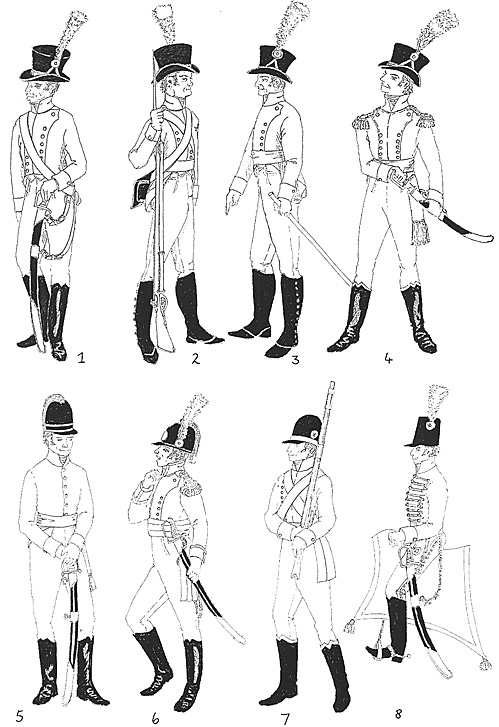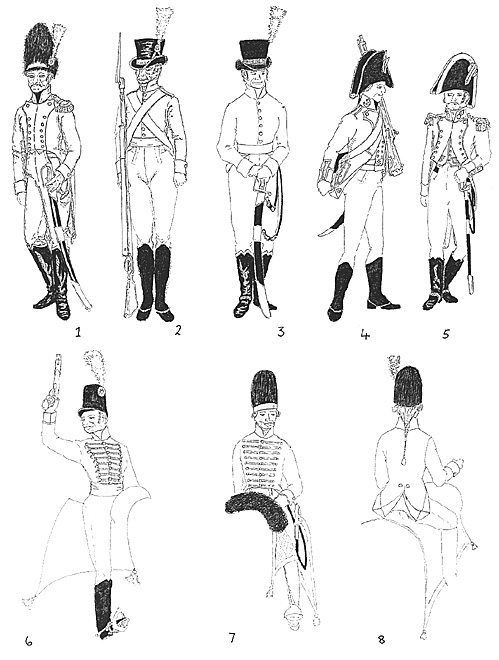Generally speaking there are so many small but essential details missing or poorly portrayed in these plates that it is very doubtful that they were painted by an artist with knowledge of the then current system of military costume and badges of rank. Indeed the shabracks and the harness of the cavalry regiments shown are so peculiar that one must conclude that they were painted by a non-horseman and based only on a verbal description. When officers are shown, epaulettes are rarely visible, waist sashes [an essential badge of commissioned rank for infantry officers of the day in Europe] are missing as are the golden sword/sabre knots. Sabre slings are rarely shown. Officers' coat skirts at this time reached to the back of the knee; this is shown correctly in the case of the Grenaderos but most of the other figures are shown with either extremely brief coat tails [reminiscent of the 1812-15 period in most European armies] or none at all, as if the regiment wore hussar-style dolmans or shell jackets.
Many figures are shown wearing what appear to be waist sashes [Patricios, Artilleria and Artilleros, Correntinos, Pardos, Morenos, and Maestranza] but, due to other items of equipment such as muskets and bandoliers cannot be officers whereas why should an officer of Indies be shown in a "dolman" without sash, epaulettes, sabre slings or strap? Buttons and lace design are rarely distinguishable.
Details of the helmets are weak and contradictory, in the case of the mounted figure of the Carabineros de Errera, the headgear is reminiscent of a highlander's feather bonnet [which may indeed be possible!]
Most hair seems to be cut short but the Carabineros de Carlos IV are very clearly shown to be wearing powdered, queued and clubbed hair in the old style. In conclusion, this series of figures [as a contemporary record of an army] is confusing mainly due to the fact that one must regard it as possibly being "accurate" in the sense that it truly reflects the lack of uniformity and standardization which would undoubtedly exist in any military force hastily called together to defend thier homeland. It is generally the case that contemporary records tend to present the theoretical standard uniform rather than the less adequate reality, although there are of course notable exceptions to this general rule such as the Brothers Suhr in Hamburg and the Frankfurt Collection.
Sources used in the preparation of this article:
- 1. "Les Invasiones Inglesas del Rio de la Plata [1806-1807), by Carlos Roberts, Tte.Col.del Reserva. Buenos Aires 1938.
2. Plan que demuestra Ins Tercios Voluntarios asi de Cavalleria como de Infanteria que se ban uniformado a costa del publico para defence del Rey y de la Patria.
3. Argentine Dress Regulations [Army] 1985.
KEY TO PLATES
Plate 1. Fiq.1.0fficer Battalion Montaneaes,
Fig.2. Private Batt. Gallogos,
Fig.3. 0ff. Batt. Ninos,
Fig.4. 0ff. Batt. Viscainos
Fig.5. 0ff. Batt. Pardos,
Fig.6. 0ff. Artilleros,
Fig.7. Pte. Batt. Morenos,
Fig.8. Off. Hussars of Puyrredon.
Plate 2.
Fig.1. Off. Batt. Grenadiers,
Fig.2. Pte. Batt. Patriclos,
Fig.3. Off. Batt. Migueletes,
Fig.4 Pte. Spanish Marine
Fig.5. Off. Spanish Foot Artillery,
Fig.6. Off. Hussars de Vivas,
Fig.7. Off. Carabineros de Errera,
Fig.8. Off. Carabineros de Carlos IV.


Back to Table of Contents -- El Dorado Vol II No. 5
Back to El Dorado List of Issues
Back to MagWeb Master Magazine List
© Copyright 1990 by The South and Central Military Historians Society
This article appears in MagWeb.com (Magazine Web) on the Internet World Wide Web.
Other articles from military history and related magazines articles are available at http://www.magweb.com